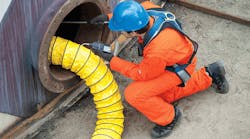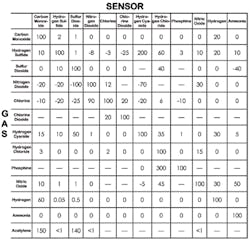Being responsible for customer training, I have had the privilege of meeting thousands of safety professionals. I have a very talented team with a particular understanding of adult learning and of knowledge transfer from teacher to student. I ask everyone I meet a simple question: "Are you leaving this class with fundamentals that you can immediately apply to your working life and, will this information ultimately keep you and those around you safer?"
While the answer is always "yes," I further probe to learn what they found valuable and useful in the training. I felt this was a good opportunity to share a few examples of things students have learned through gas detection training in the hope that I might answer a couple of questions that you might have about gas detection.
Sampling Takes Time
Best practices state that a worker should sample prior to entry, continuously during entry and prior to re-entry into a confined space. Because some gases are lighter than air and others are heavier than air, stratification can occur. Gas samples should be taken in 4-foot intervals in every direction of travel to address this gas stratification. Gas monitors and their sampling pumps are great tools to use in doing this, but they are not magic wands. They need time to do their job. This is a common oversight made by many gas detection end users.
The first thing to consider is sample time. For most gas monitors, the flow rate is between 0.25 and 0.5 liters per minute. When pulling a gas through sample tubing, it is best to allow 2 seconds per foot of tubing for the sample to travel. Additionally, a gas monitor needs time to react once the sample is delivered to the sensors. Most gas monitors will reach to 90 percent of the applied gas in 30 seconds with a fresh sample delivered, and 100 percent of the applied gas in 120 seconds.
For example, if we were taking a sample through 20 feet of tubing, the sample time would be 2 seconds per foot of tubing or 40 seconds (2 x 20) to deliver the sample. Time also should be allowed for the gas monitor to react to the sample. To reach 100 percent response, an additional 2 minutes would be required. In this example, when sampling through 20 feet of tubing, the user would need to allow 2 minutes and 40 seconds to obtain 100 percent response and an accurate sample.
Cross Sensitivity Does Occur
In a perfect world, a toxic gas sensor only would react to the gas it is targeted to monitor; which means other toxic gases should not cause an inaccurate response. A carbon monoxide sensor only would detect carbon monoxide and a hydrogen sulfide sensor only would detect hydrogen sulfide. Unfortunately, technology has not yet made this a reality and while most sensors are quite specific, cross sensitivity does occur.
Cross sensitivity is a sensor’s reaction to an interfering gas. Exposing a sensor to a gas that is not the target gas can cause an undesirable response, either positive or negative. With a positive cross sensitivity, the user can get the impression that more of a target gas is present than actually is present. This may cause the user to induce ventilation or take corrective action to remove the gas hazard, which may not be necessary. This condition causes the user to err on the safe side and while it is inconvenient, it does not cause a safety concern.
When a cross sensitivity is negative, it is a greater concern. In this case, you may have a cross-sensitive gas that causes the sensor to react in a negative manner. If this is the only gas present, the user will see a negative number on the gas monitor’s display and may elect to zero the instrument or assume there is a problem with the instrument. Even worse, if a negative cross-sensitive gas and the target gas exist together, you may have a cancelling effect. This can be potentially dangerous if you are unaware of this phenomenon or do not know the potential gases in a sample.
Most gas detection manufacturers publish toxic gas sensor cross sensitivity charts. These charts can help the user understand and anticipate cross-sensitive conditions with their gas monitors and empower them to react accordingly. In this sample chart, the sensor type is along the top axis and the sample gas is along the side access. To help you better understand how to read this chart, we will use carbon monoxide as an example.
If our target gas is carbon monoxide and we have 50 ppm of hydrogen gas present, we can use the chart to determine the cross sensitivity of a hydrogen gas exposure on a carbon monoxide sensor. In this case, it is 60 percent, which means if we have 50 ppm hydrogen present, we can multiply 50 x 0.6 (60 percent) and estimate our cross-sensitive response to appear as 30 ppm carbon monoxide when in fact we have only hydrogen present. Of course, we could have a combination of gases that ultimately will raise the complexity of the situation.
If our target gas is carbon monoxide, and we have 40 ppm of nitrogen dioxide gas present, we can use the chart to determine the cross sensitivity of a nitrogen dioxide gas exposure on a carbon monoxide sensor. In this case, it is -20 percent, which means that if we have 40 ppm nitrogen dioxide present we can multiply 40 x -0.2 (-20 percent) and estimate our cross sensitive response to appear as -8 ppm carbon monoxide when in fact we have only nitrogen dioxide present.
Confined spaces are dangerous places to work and those who enter must make decisions that will ensure their safety and the safety of those around them. Having a better understanding of the gases that are present, how to sample for them and how they will react can mean the difference between a safe or unsafe condition. Today, there are many training options designed to provide workers the tools needed to ensure they go home safely at the end of their shift.
Dave Kuiawa is the director of training and field services at Industrial Scientific Corp. Kuiawa has been with the company for 24 years and has held positions in customer service, repair service, training, product management, sales and field services. He can be reached at dkuiawa@indsci
.com.

